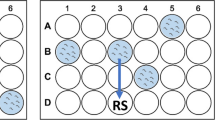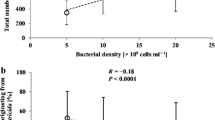Abstract
Entomoparasitic nematodes (EPNs) are being commercialized as a biocontrol measure for crop insect pests, as they provide advantages over common chemical insecticides. Mass production of these nematodes in liquid media has become a major challenge for commercialization. Producers are not willing to share the trade secrets of mass production and by doing so, have made culturing EPNs extremely difficult to advance existing technologies. Theoretically, mass production in liquid media is an ideal culturing method as it increases cost efficiency and nematode quantity. This paper will review current culturing methodologies and suggest basic culturing parameters for mass production. This review is focused on Heterorhabditis bacteriophora; however, this information can be useful for other nematode species.














Similar content being viewed by others
References
Bathon H (1996) Impact of entomopathogenic nematodes on non-target hosts. Biocontrol Sci Technol 6:421–434
Bedding RA, Akhurst RJ, Kaya HK (1993) Future prospects for entomogenous and entomopathogenic nematodes. In: Bedding RA, Akhurst RJ, Kaya HK (eds) Nematodes and the biological control of insect pests. CSIRO, Melbourne, pp 157–170
Ehlers RU (2003) Entomopathogenic nematodes in the European biocontrol market. Commun Agric Appl Biol Sci 68(4a):3–16
Ehlers RU, Hokkanen HM (1996) Insect biocontrol with non-endemic entomopathogenic nematodes (Steinernema spp. and Heterorhabditis spp.): conclusions and recommendations of a combined OECD and COST workshop on scientific and regulatory policy issues. Biocontrol Sci Technol 6:295–302
Gaugler R, Han R (2002) Production Technology. In: Gaugler R (ed) Entomopathogenic nematology. CAB International, Cambridge, pp 289–310
Shapiro-Ilan DI, Gaugler R (2002) Production technology for entomopathogenic nematodes and their bacterial symbionts. J Ind Microbiol Biotechnol 28:137–146
Williams RN, Fickle DS, Grewal PS, Dutcher J (2010) Field efficacy against the grape root borer Vitacea polistiformis (Lepidoptera: Sesiidae) and persistence of Heterorhabditis zealandica and H. bacteriophora (Nematoda: Heterorhabditidae) in vineyards. Biol Control 53:86–91
Boemare NE, Laumond C, Mauleon H (1996) The entomopathogenic nematode–bacterium complex: biology, life cycle and vertebrate safety. Biocontrol Sci Technol 6:333–345
Mahar AN, Jan ND, Mahar AQ, Mahar GM, Hullio MH, Lanjar AG (2008) Efficacy of entomopathogenic bacterium Photorhabdus luminescens and its metabolites against diamondback moth Plutella xylostella larvae on chinese cabbage and artificial diet. Pak J Nematol 26(1):69–82
Bowen D, Rocheleau TA, Blackburn M, Andreev O, Golubeva E, Bhartia R, Ffrench-Constant RH (1998) Insecticidal toxins from the bacterium Photorhabdus luminescens. Science 280:2129–2132
Mohan S, Sabir N (2005) Biosafety concerns on the use of Photorhabdus luminescens as biopesticide: experimental evidence of mortality in egg parasitoid Trichogramma spp. Curr Sci 89(7):1268–1272
Wouts WM (1981) Mass production of the entomopathogenic nematode Heterorhabditid heliothidis (Nematoda: Heterorhabditidae) on artificial media. J Nematol 13(4):467–469
de la Torre M (2003) Challenges for mass production of nematodes in submerged culture. Biotechnol Adv 21:407–416
Tabassum KA, Shahina F (2004) In vitro mass rearing of different species of entomopathogenic nematodes in monoxenic solid culture. Pak J Nematol 22(2):167–175
Friedman MJ (1990) Commercial production and development. In: Gaugler R (ed) Entomopathogenic nematodes in biological control. CRC Press, Boca Raton, pp 152–172
Friedman MJ, Langston SE, Pollitt S (1991) Mass production in liquid culture of insect-killing nematodes. United States Patent, 5,023,183. Accessed on 3 Oct 2011
Gouge DH, Snyder JL (2006) Temporal association of entomopathogenic nematodes (Rhabditida: Steinernematidae and Heterorhabditidae) and bacteria. J Invertebr Pathol 91:147–157
Li XY, Cowles RS, Cowles EA, Gaugler R, Cox-Foster DL (2007) Relationship between the successful infection by entomopathogenic nematodes and the host immune response. Int J Parasitol 37:365–374
Waterfield NR, Ciche T, Clarke D (2009) Photorhabdus and a host of hosts. Annu Rev Microbiol 63:557–574
Nguyen KB, Smart GC Jr (1998) Morphology of the life stages of three Heterorhabditis spp. from the infective juvenile to the hermaphrodite. Proc Soil Crop Sci Soc Fla 57:101–107
Kahel-Raifer H, Glazer I (2000) Environmental factors affecting sexual differentiation in the entomopathogenic nematode Heterorhabditis bacteriophora. J Exp Zool 287:158–166
Poinar GO, Thomas GM, Hess R (1977) Characteristics of the specific bacterium associated with Heterorhabditis bacteriophora. Nematol 23:97–102
Forst S, Clarke D (2002) Bacteria-nematode symbiosis. In: Gaugler R (ed) Entomopathogenic nematology. CAB International, Wallingford, pp 57–77
Munch A, Stingl L, Jung K, Heermann R (2008) Photorhabdus luminescens genes induced upon insect infection. BMC Genomics 9:229
Akhurst RJ (1983) Antibiotic activity of Xenorhabdus spp. bacteria symbiotically associated with insect pathogen nematodes of the families Heterorhabditidae and Steinernematidae. J Gen Microbiol 128:3061–3066
Duchaud E, Rusniok C, Frangeul L et al (2003) The genome sequence of the entomopathogenic bacterium Photorhabdus luminescens. Nat Biotechnol 21:1307–1313
Somvanshi VS, Kaufmann-Daszczuk B, Kim K, Mallon S, Ciche TA (2010) Photorhabdus phase variants express a novel fimbrial locus, mad, essential for symbiosis. Mol Microbiol 77(4):1021–1038
Brugirard-Ricaud K, Duchaud E, Givaudan A, Girard PA, Kunst F, Boemare N, Brehelin M, Zumbihl R (2005) Site-specific antiphagocytic function of Photorhabdus luminescens type III secretion system during insect colonization. Cell Microbiol 7(3):363–371
Daborn PJ, Waterfield N, Silva CP, Au CPY, Sharma S, Ffrench-Constant RH (2002) A single Photorhabdus gene, makes caterpillars floppy (mcf), allows Escherichia coli to persist within and kill insects. Proc Natl Acad Sci USA 99(16):10742–10747
Ruby EG, Urbanowski M, Campbell J (2005) Complete gene sequence of Vibrio Fischeri: a symbiotic bacterium with pathogenic congeners. Proc Natl Acad Sci USA 102(8):3004–3009
Brenner DJ, Farmer JL III (2005) Family I. Enterobacteriaceae. In: Garrity GM, Brenner DJ, Krieg NR, Staley TJ (eds) Bergey’s manual of systematic bacteriology, volume 2, the proteobacteria, Part B: the gammaproteobacteria, 2nd edn. Spinger, New York, pp 587–607
Gerritsen LJM, Smits PH (1997) The influence of Photorhabdus luminescens strains and form variants on the reproduction and bacterial retention of Heterorhabditis megidis. Fundam Appl Nematol 20(4):317–322
Plichta KL, Joyce SA, Clarke D, Waterfield N, Stock SP (2009) Heterorhabditis gerrardi n. sp. (Nematoda: Heterorhabditidae): the hidden host of Photorhabdus asymbiotica (Enterobacteriaceae: γ-Proteobacteria). J Helminthol 83:309–320
Han R, Wouts WM, Li L (1990) Development of Heterorhabditis spp. strains as characteristics of possible Xenorhabdus luminescens subspecies. Rev Nematol 13(4):411–415
Bedding RA (1981) Low cost in vitro mass production of Neoaplectana and Heterorhabditis species (Nematoda) for field control of insect pests. Nematologica 27:109–114
Ehlers RU, Stoessel S, Wyass U (1990) The influence of phase variants of Xenorhabdus spp. and Escherichia coli (Enterobacteriaceae) on the propagation of entomopathogenic nematodes of the genera Steinernema and Heterorhabditis. Rev Nematol 13(4):417–424
Strauch O, Ehlers RU (2000) Influence of the aeration rate on the yields of the biocontrol nematode Heterorhabditis megidis in monoxenic liquid cultures. Appl Microbiol Biotechnol 54:9–13
Strauch O, Ehlers RU (1998) Food signal production of Photorhabdus luminescens inducing the recovery of entomopathogenic nematodes Heterorhabditis spp. in liquid culture. Appl Microbiol Biotechnol 50:369–374
Boemare NE, Akhurst RJ (1988) Biochemical and physiological characterization of colony form variants in Xenorhabdus spp. (Enterobacteriaceae). J Gen Microbiol 134:751–761
Forst S, Nealson K (1996) Molecular biology of the symbiotic-pathogenic bacteria Xenorhabdus spp. and Photorhabdus spp. Microbiol Rev 60:21–43
Lango L, Clarke DJ (2010) A metabolic switch is involved in lifestyle decisions in Photorhabdus luminescens. Mol Microbiol 77(6):1394–1405
Rosner BM, Ensign JC, Schink B (1996) Anaerobic metabolism of primary and secondary forms of Photorhabdus luminescens. FEMS Microbiol Lett 140:227–232
Salaün L, Snyder LAS, Saunders NJ (2003) Adaption by phase variation in pathogenic bacteria. Adv Appl Microbiol 52:263–301
Clarke DJ (2008) Photorhabdus: a model for the analysis of pathogenicity and mutualism. Cell Microbiol 10(11):2159–2167
Crawford JM, Kontnik R, Clardy J (2010) Regulating alternative lifestyles in entomopathogenic bacteria. Curr Biol 20(1):69–74
Wouts WM (1991) Steinernema (Neoaplectana) and Heterorhabdititis species. In: Nickle WR (ed) Manual of agricultural nematology. Marcel Dekker, New York, pp 855–897
Inman FL III, Holmes LD (2012) The effects of trehalose on the bioluminescence and pigmentation of the phase I variant of Photorhabdus luminescens. J Life Sci 5:454–465
Wyatt GR, Kalf GF (1957) The chemistry of insect hemolymph. Pt II. Trehalose and other carbohydrates. J Gen Physiol 40(6):833–847
Han R, Ehlers RU (2001) Effect of Photorhabdus luminescens phase variants on the in vivo and in vitro development and reproduction of Heterorhabditis bacteriophora and Steinernema carpocapsae. FEMS Microbiol Ecol 35(3):239–247
Poinar GO (1975) Description and biology of a new insect parasitic rhabditoid, Heterorhabditis bacteriophora n. gen., n. sp. (Rhabditida; Heterorhabditidae n. fam.). Nematologica 21:463–470
Adams BJ, Fodor A, Koppenhofer HS, Stackebrandt E, Stock SP, Klein MG (2006) Biodiversity and systematics of nematode–bacterium entomopathogens. Biol Control 37:32–49
Nguyen KB, Hunt DJ (2007) Heterorhabditidae: species descriptions. In: Nguyen KB, Hunt DJ (eds) Entomopathogenic nematodes: systematics, phylogeny and bacterial symbiosis. Koninklijke NV, Leiden, pp 611–692
Zioni S, Glazer I, Segal D (1992) Life cycle and reproductive potential of the nematode Heterorhabditis bacteriophora strain HP88. J Nematol 24(3):352–358
Ehlers RU, Lunau S, Krasomil-Osterfeld K, Osterfeld KH (1998) Liquid culture of the entomopathogenic nematode–bacterium-complex Heterorhabditis megidis/Photorhabdus luminescens. Biocontrol 43:77–86
Stanbury PF, Whitaker A, Hall SJ (2003) Principles of fermentation technology, 2nd edn. Oxford Press, Butterworth, Heinemann
Bleakley B, Nealson KH (1988) Characterization of primary and secondary forms of Xenorhabdus luminescens strain Hm. FEMS Microbiol Ecol 53:241–250
Dunphy GB (1995) Physicochemical properties and surface components of Photorhabdus luminescens influencing bacteria interaction with non-self response systems of nonimmune Galleria mellonella larvae. J Invertebr Pathol 65:25–34
Pellerone FI, Archer SK, Behm CA, Grant WN, Lacey MJ, Somerville AC (2003) Trehalose metabolism genes in Caenorhabditis elegans and filarial nematodes. Int J Parasitol 33:1195–1206
Chandra GK, Chater F, Bornemann S (2011) Unexpected and widespread connections between bacterial glycogen and trehalose metabolism. Microbiol 157:1565–1572
Jain NK, Roy I (2008) Effect of trehalose on protein structure. Protein Sci 18:24–36
Iturriaga G, Suarez R, Nova-Franco B (2009) Trehalose metabolism: from osmoprotection to signaling. Int J Mol Sci 10:3793–3810
Ohtake S, Wang YJ (2010) Trehalose: current use and future applications. J Pharm Sci 100(6):2020–2053
Krasomil-Osterfeld KC (1995) Influence of osmolarity on phase shift in Photorhabdus luminescens. Appl Environ Microbiol 61(10):3748–3749
Moreau E, Inman FL III, Singh S, Walters H, Holmes LD (2011) Remote control of fed-batch fermentation systems. J Chem Chem Eng 5:897–902
Singh S, Moreau E, Inman III FL, Holmes LD (2011). Characterization of Photorhabdus luminescens growth for the rearing of the beneficial nematode Heterorhabditis bacteriophora. Indian J Microbiol. doi:10.1007/s12088-011-0238-7
Yoo SK, Brwon I, Gaugler R (2000) Liquid media development for Heterorhabditis bacteriophora: lipid source and concentration. Appl Microbiol Biotechnol 54:759–763
Garcia-Ochoa F, Gomez E (2009) Bioreactor scale-up and oxygen transfer rate in microbial processes: an overview. Biotechnol Adv 27:153–176. doi:10.1016/j.biotechadv.2008.10.006
Baliadi Y, Yosiga T, Kondo E (2001) Development of endotokia matricida and emergence of originating infective juveniles of Steinernematid and Heterorhabditid nematodes. Jpn J Nematol 31(1/2):26–35
Surrey MR, Davies RJ (1996) Pilot-scale liquid culture and harvesting of an entomopathogenic nematode, Heterorhabditis bacteriophora. J Invertebr Pathol 67:92–99
Acknowledgments
Financial support is provided in part by the National Institute of Child Health and Development (5G11HD052381-05); the North Carolina Biotechnology Center (2010-IDG-1008); and Farm Bureau of Robeson County, North Carolina USA.
Author information
Authors and Affiliations
Corresponding author
Rights and permissions
About this article
Cite this article
Inman, F.L., Singh, S. & Holmes, L.D. Mass Production of the Beneficial Nematode Heterorhabditis bacteriophora and Its Bacterial Symbiont Photorhabdus luminescens . Indian J Microbiol 52, 316–324 (2012). https://doi.org/10.1007/s12088-012-0270-2
Received:
Accepted:
Published:
Issue Date:
DOI: https://doi.org/10.1007/s12088-012-0270-2




